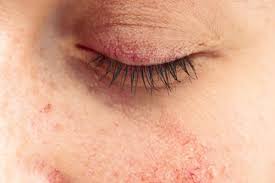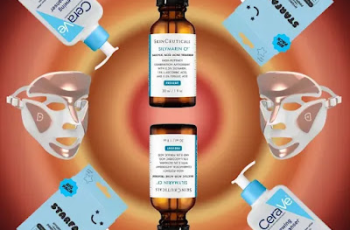
What is Ocular Rosacea? A Complete Guide to Symptoms and Causes
If you often have red, itchy, or swollen eyes, or frequently get styes, don’t ignore these signs. They could be more than just allergies or clogged tear glands.
Sometimes, these symptoms point to a condition called ocular rosacea.
Understanding Ocular Rosacea
Ocular rosacea is a type of rosacea that affects the eyes and eyelids. Rosacea is a long-term skin condition that mainly causes redness and inflammation, often on the face.
It most often happens in women aged 30 to 50. But ocular rosacea can affect both men and women equally.
Up to 58% of people who have rosacea on their skin also have eye problems from ocular rosacea.
Interestingly, about 20% of people with ocular rosacea do not have any skin symptoms before their eye symptoms start. This means you can have ocular rosacea even if your skin looks clear and healthy.
What Are the Symptoms of Ocular Rosacea?
Ocular rosacea can cause many different symptoms, and these can affect different parts of your eyes and eyelids. You might notice one or more of these signs regularly:
Your eyes may be red, itchy, or burning.
Your eyes might feel watery or like they have something gritty inside.
You might feel your eyes are dry and uncomfortable.
Bright lights may hurt your eyes or cause discomfort.
Your eyelids could look swollen or inflamed—a condition called blepharitis.
You may see tiny red veins in your eyelids near your eyelashes.
You might get frequent eyelid infections, such as styes or chalazions (small lumps on the eyelid).
Your corneas, the clear front part of your eyes, can become inflamed. This can cause blurred vision or even vision loss if untreated.
What Causes Ocular Rosacea?
Doctors do not yet know exactly what causes ocular rosacea. However, several factors may increase your risk or contribute to the condition:
Heredity: If one or both of your parents have rosacea, you are more likely to develop it.
Bacterial infection: A common stomach bacteria called Helicobacter pylori is linked to eye inflammation in some cases.
Blocked eyelid glands: Your eyelids have tiny oil glands (called meibomian glands) that help keep your eyes moist. If these glands get clogged, it can lead to dryness and inflammation.
Eyelash mites: Everyone has tiny mites living near the eyelashes, but people with rosacea tend to have more of these mites. They may worsen inflammation.
How is Ocular Rosacea Diagnosed?
There is no single test that can diagnose ocular rosacea. Instead, doctors look at your medical history and carefully examine your eyes.
To be diagnosed with ocular rosacea, you usually must show at least two symptoms, and often skin symptoms of rosacea as well. But remember, some people have ocular rosacea without skin signs.
Ocular rosacea is classified into three stages:
Grade 1 (Mild): Mild itching, burning, or a gritty feeling in the eyes.
Grade 2 (Moderate): More intense burning, stinging, or crustiness around the eyes and lids.
Grade 3 (Severe): Pain, sensitivity to light, or blurry vision.
How is Ocular Rosacea Treated?
While there is no cure for ocular rosacea, treatments can reduce symptoms and prevent damage to your eyes. Early treatment is important because untreated ocular rosacea can lead to permanent vision problems.
Your treatment plan depends on how severe your symptoms are. Usually, the first step is to improve eyelid hygiene:
Wash your eyelids gently twice a day with warm water or diluted baby shampoo.
Use artificial tears (eye drops) to relieve dryness.
Avoid eye makeup during flare-ups. If you must wear makeup, choose fragrance-free and non-oily products.
Do not wear contact lenses when your eyes are inflamed or dry.
Avoid triggers that worsen rosacea, like spicy foods or alcohol.
If symptoms are worse, your doctor may prescribe antibiotics. These can be taken by mouth or applied as eye drops. Common antibiotics include doxycycline, tetracycline, minocycline, azithromycin, and erythromycin.
Antibiotics help reduce infection and calm inflammation. Usually, doctors prescribe lower doses for longer times to control symptoms safely.
Sometimes, if inflammation is severe or other treatments don’t work, doctors may recommend steroid eye drops. These help reduce swelling but should only be used for a short time.
Long-term use of steroids can cause eye problems like glaucoma or cataracts.
A safer alternative for long-term inflammation control is topical cyclosporine. This medicine suppresses the immune system locally and helps especially with dry eyes.
Some studies suggest that taking Omega-3 fatty acids (found in fish oil supplements) may ease dry eye symptoms and inflammation.
If you have stubborn lumps on your eyelids, like chalazions or styes, surgery might be needed to remove them.
What Triggers Ocular Rosacea Flare-Ups?
Ocular rosacea often worsens with the same triggers that affect skin rosacea. If you have both conditions, you might notice flare-ups in your eyes and skin together. Common triggers include:
Eating spicy foods.
Drinking alcohol.
Exposure to sunlight, wind, or very hot or cold weather.
Strong emotions such as stress, anger, or embarrassment.
Intense exercise.
Hot baths or saunas.
Avoiding your personal triggers can help keep symptoms under control.
When Should You See a Doctor?
If your eyes are red, itchy, or burning regularly, see your primary care doctor. They can examine you and refer you to an eye specialist, like an optometrist or ophthalmologist, if needed.
You should also visit an eye doctor if your symptoms get worse or if flare-ups happen more often. Be sure to tell them about any new symptoms or things that trigger your condition.
Go to the emergency room if you experience any of the following:
Severe eye pain.
Dizziness.
Loss of vision.
Blurry or double vision.
These can be signs of serious eye problems that need immediate treatment.
Living with Ocular Rosacea
Although ocular rosacea cannot be cured, proper treatment and good eye care can keep symptoms manageable. By working closely with your doctor, you can create a plan to control the condition and protect your vision.
Regular eyelid hygiene, avoiding triggers, and following treatment recommendations help prevent flare-ups and reduce discomfort.
DQH Knowledge drop: In your 20s, your skin cell turnover decreases. (Cell turnover is a key component in keeping your skin youthful.) You know what else slows down? Your collagen production. Starting in your 20s, collagen decreases by about 1 percent per year. Should you want to prevent fine lines and wrinkles, start by eliminating behaviors that contribute to premature aging. “If it’s bad for you, it’s bad for your skin,” says dermatologist Michel Somenek.
“Cigarette smoking reduces blood flow to the skin and causes premature wrinkling and a dull skin texture. Making the repeated pursed motion to inhale can also cause smoker’s lines. Alcohol and recreational drugs are toxins for the skin that damage its cellular structure and DNA,” Somenek tells us. “The faster you eliminate vices while you are young, the better chance your skin and body have to recuperate.” Also, adopting an anti-aging routine in your 20s is key. After all, the best offense is a good defense. We spoke to Somenek and experts Joshua Ross and Audrey Kunin to find out more.
Keep reading for the best anti-aging products for your 20s, according to skincare professionals.
Sunscreen
“We all know that the sun is the number one cause of skin aging and starting the prevention in your 20s is very important,” Ross says. “The majority of your sun damage won’t start to appear until you’re in your 30s, so don’t wait until you see it surface or you’ll be behind the curve. Stay ahead of it with a good-quality zinc-based sunscreen worn daily.”
Farmacy Green Defense Daily Mineral Sunscreen
An invisible sunscreen with SPF 30, plus botanical extracts meant to protect skin with tons of antioxidants. Bonus: It’s clean and fine to use under makeup.
Bareminerals Complexion Rescue™ Tinted Moisturizer Broad Spectrum SPF 30
Although we recommend you use your SPF and moisturizer separately, we also understand moments when you don’t have time or energy for that extra step. For those times, this bareMinerals moisturizer is a great thing to have on hand.
Vitamin C Serum
“A great introduction to anti-aging is to start with a vitamin C serum in your morning skincare routine,” Ross says. “It’s a powerful antioxidant that will neutralize free radicals and brighten the skin.” He adds that it’s a great way to counteract the effects of the sun’s harmful rays, which, as previously mentioned, are among the biggest causes of premature aging.
Drunk Elephant C-Firma™ Vitamin C Day Serum
The Drunk Elephant C-Firma is a lightweight serum that promises to give skin a glow by combining the brightening powers of vitamin C with ferulic acid, l-ascorbic acid, and vitamin E. The included sodium hyaluronate is meant to replace hydration loss, so you shouldn’t have to deal with any irritation.
Sunday Riley C.E.O. Rapid Flash Brightening Serum
This potent serum is jam-packed with vitamin C (15 percent, to be exact), which means it’s a potential superstar at both brightening skin and dousing it in antioxidants.
Peptides
Using peptides on your skin has many benefits, says Somenek. “The skin barrier is what defends the body against pollution, UV rays, bacteria, and toxins. It can be damaged by several everyday factors. Using topical peptides aids in building a stronger barrier,” he says. “Peptides comprise elastic fibers, which are a type of protein. These fibers help to make skin appear taut and firm. Peptides can also help repair damaged skin, relieve inflammation, and even out skin tone. Some peptides can kill acne-causing bacteria that is common in 20-somethings.”
Kunin agrees, saying, “Peptides are an excellent entry point for supporting collagen.” She recommends looking for face and eye treatments that contain these collagen-boosting powerhouses.
Charlotte Tilbury Magic Eye Rescue Cream
This Charlotte Tilbury super-emollient eye cream has a base of coconut oil and shea butter (read: it’s incredibly hydrating). Botanicals plus peptides are meant to help reduce dark circles and boost collagen, respectively.
This creamy moisturizer serves up potent collagen-boosting peptides and pycnogenol, and antioxidant-rich vitamin C. “Instead of sitting on top of the skin, peptides penetrate the outer layer so they go deep. The ‘signals’ they send tell the cells to produce elastin and collagen, which are needed for youthful-looking skin,” explains Somenek.
At-Home Peel Pads
Remember that skin cell turnover fiasco we talked about earlier? One way to help support it is by exfoliating. “Exfoliation is important to help keep skin fresh and luminous,” Kunin says. She recommends using at-home peel pads as an easy and effective way to exfoliate.
“The goal in your 20s is to fight the slowing pace of cell turnover. It is wise to use products that gently exfoliate, yet still remove oil and other impurities. Products that have Alpha Hydroxy Acids (AHA) or Beta Hydroxy Acids (BHA) are a good choice.”
According to Somenek, you should only exfoliate two to three times a week. “People of all ages are guilty of over-exfoliating and that can be too much of a good thing,” he says.
Dermadoctor Kakadu C Intensive Vitamin C Peel Pad
A few swipes of this Derma Doctor powerful peel pad promise to leave your skin glowing and smooth, thanks to the seven (yes, seven) types of chemical exfoliants, including AHA and BHA. It also contains vitamin C via Kakadu plum extract for added brightening and antioxidant protection.
KEY INGREDIENTS Kakadu plum extract is sourced from the Kakadu plum, a fruit grown in northern Australia. It contains vitamin C, which restores the skin’s natural barrier, increases collagen production, and soothes irritation.
Dr. Dennis Gross Skincare Alpha Beta® Universal Daily Peel Pads
These are the gold standard of peel pads, with a cult following and over 900 five-star reviews on Sephora. They’re easy to use and contain a blend of anti-aging exfoliating acids.
Emollient Night Cream
“In your 20s, you need to start upping the hydration in your skincare routine. You may have been cautious of over-moisturizing because of acne in your teens, but as you enter your 20s, your skin transitions and becomes drier,” Ross says. “I recommend an emollient night cream added into your evening skincare regimen.”
“Twenty-somethings need to make sure that they are not using creams that will clog their pores and cause excess oil production,” says Somenek. Opt for non-comedogenic products.
Cerave Skin Renewing Night Cream
One great choice is the CeraVe Skin Renewing Night Cream, which is a non-comedogenic night cream that leaves skin soft and glowy. It combines the moisturizing powers of ceramides and hyaluronic acid.
RoC Retinol Correxion Max Hydration Creme
“The best night cream ingredients contain retinol, benzoyl peroxide, and/or salicylic acid or hyaluronic acid. The goal is to moisturize, yet remove excess oil,” says Somenek. This Roc Retinol Correxion cream fits the bill as it contains both hyaluronic acid and retinol so it promises to moisturize while also being non-comedogenic.



